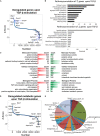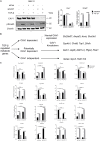Caveolin-1 Impacts on TGF-β Regulation of Metabolic Gene Signatures in Hepatocytes
- PMID: 32082178
- PMCID: PMC7005071
- DOI: 10.3389/fphys.2019.01606
Caveolin-1 Impacts on TGF-β Regulation of Metabolic Gene Signatures in Hepatocytes
Abstract
Caveolin-1 (CAV1) is a membrane protein associated with metabolism in various cell types. The transforming growth factor beta (TGF-β) is a pro-fibrogenic cytokine in the liver, but its metabolic gene signatures remain unclear to date. We have previously shown that CAV1 alters TGF-β signaling and blocks its pro-apoptotic function. Here, we defined TGF-β-induced metabolic gene signatures in hepatocytes and assessed whether CAV1 abundance affects TGF-β control of those metabolic genes. Microarray analyses of primary hepatocytes after TGF-β stimulation (48 h) showed differential expression of 4224 genes, of which 721 are metabolic genes (adjusted p < 0.001). Functional annotation analysis revealed that TGF-β mainly suppresses metabolic gene network, including genes involved in glutathione, cholesterol, fatty acid, and amino acid metabolism. TGF-β also upregulated several genes related to glycan metabolism and ion transport. In contrast to TGF-β effects, CAV1 knockdown triggered the upregulation of metabolic genes. Immortalized mouse hepatocytes (AML12 cells) were used to validate the gene changes induced by TGF-β stimulation and CAV1 knockdown. Noteworthy, of the TGF-β metabolic target genes, CAV1 modulated the expression of 228 (27%). In conclusion, we present several novel metabolic gene signatures of TGF-β in hepatocytes and show that CAV1 abundance alters almost a third of these genes. These findings could enable a better understanding of TGF-β function in normal and diseased liver especially where differential CAV1 level is implicated.
Keywords: caveolin-1; liver diseases; metabolism; microarray; transforming growth factor beta.
Copyright © 2020 Han, Nwosu, Piorońska, Ebert, Dooley and Meyer.
Figures




Similar articles
-
The level of caveolin-1 expression determines response to TGF-β as a tumour suppressor in hepatocellular carcinoma cells.Cell Death Dis. 2017 Oct 12;8(10):e3098. doi: 10.1038/cddis.2017.469. Cell Death Dis. 2017. PMID: 29022911 Free PMC article.
-
Caveolin-1-dependent activation of the metalloprotease TACE/ADAM17 by TGF-β in hepatocytes requires activation of Src and the NADPH oxidase NOX1.FEBS J. 2016 Apr;283(7):1300-10. doi: 10.1111/febs.13669. Epub 2016 Feb 22. FEBS J. 2016. PMID: 26815118
-
Distinct dedifferentiation processes affect caveolin-1 expression in hepatocytes.Cell Commun Signal. 2013 Jan 22;11(1):6. doi: 10.1186/1478-811X-11-6. Cell Commun Signal. 2013. PMID: 23339737 Free PMC article.
-
Cooperation of liver cells in health and disease.Adv Anat Embryol Cell Biol. 2001;161:III-XIII, 1-151. doi: 10.1007/978-3-642-56553-3. Adv Anat Embryol Cell Biol. 2001. PMID: 11729749 Review.
-
Caveolin-1 in the regulation of cell metabolism: a cancer perspective.Mol Cancer. 2016 Nov 16;15(1):71. doi: 10.1186/s12943-016-0558-7. Mol Cancer. 2016. PMID: 27852311 Free PMC article. Review.
Cited by
-
Synapsin-Promoted Caveolin-1 Overexpression Maintains Mitochondrial Morphology and Function in PSAPP Alzheimer's Disease Mice.Cells. 2021 Sep 20;10(9):2487. doi: 10.3390/cells10092487. Cells. 2021. PMID: 34572135 Free PMC article.
-
Retinoic acid generates a beneficial microenvironment for liver progenitor cell activation in acute liver failure.Hepatol Commun. 2024 Jul 18;8(8):e0483. doi: 10.1097/HC9.0000000000000483. eCollection 2024 Aug 1. Hepatol Commun. 2024. PMID: 39023343 Free PMC article.
-
Serum Caveolin-1 Level is Inversely Associated with Serum Vaspin, Visfatin, and HbA1c in Newly Diagnosed Men with Type-2 Diabetes.Rep Biochem Mol Biol. 2022 Jul;11(2):299-309. doi: 10.52547/rbmb.11.2.299. Rep Biochem Mol Biol. 2022. PMID: 36164629 Free PMC article.
-
Dual signaling pathways of TGF-β superfamily cytokines in hepatocytes: balancing liver homeostasis and disease progression.Front Pharmacol. 2025 Apr 7;16:1580500. doi: 10.3389/fphar.2025.1580500. eCollection 2025. Front Pharmacol. 2025. PMID: 40260391 Free PMC article. Review.
-
The immune-modulatory dynamics of exosomes in preeclampsia.Arch Gynecol Obstet. 2025 Jun;311(6):1477-1487. doi: 10.1007/s00404-025-08013-7. Epub 2025 Apr 3. Arch Gynecol Obstet. 2025. PMID: 40178562 Free PMC article. Review.
References
LinkOut - more resources
Full Text Sources
Molecular Biology Databases

